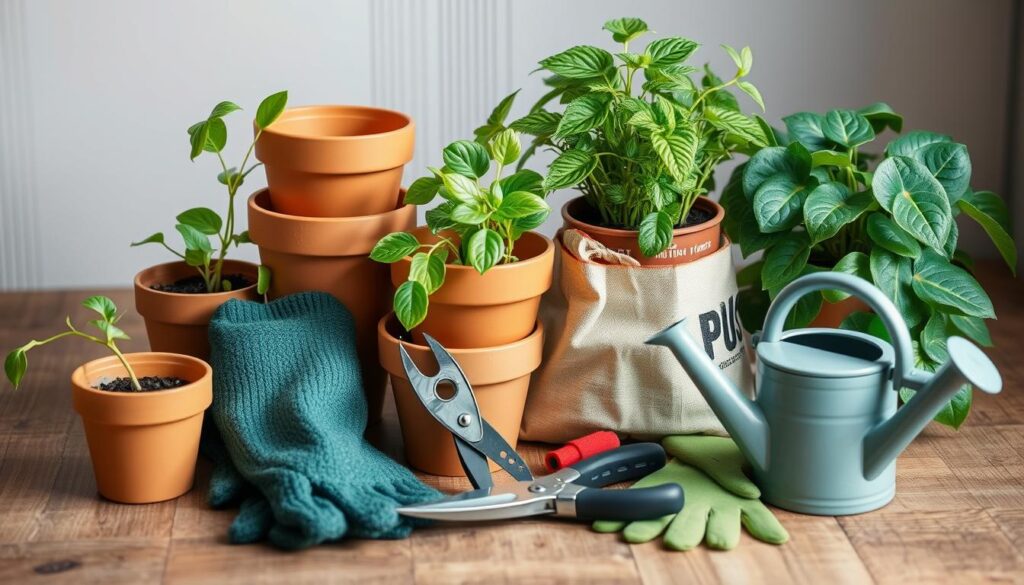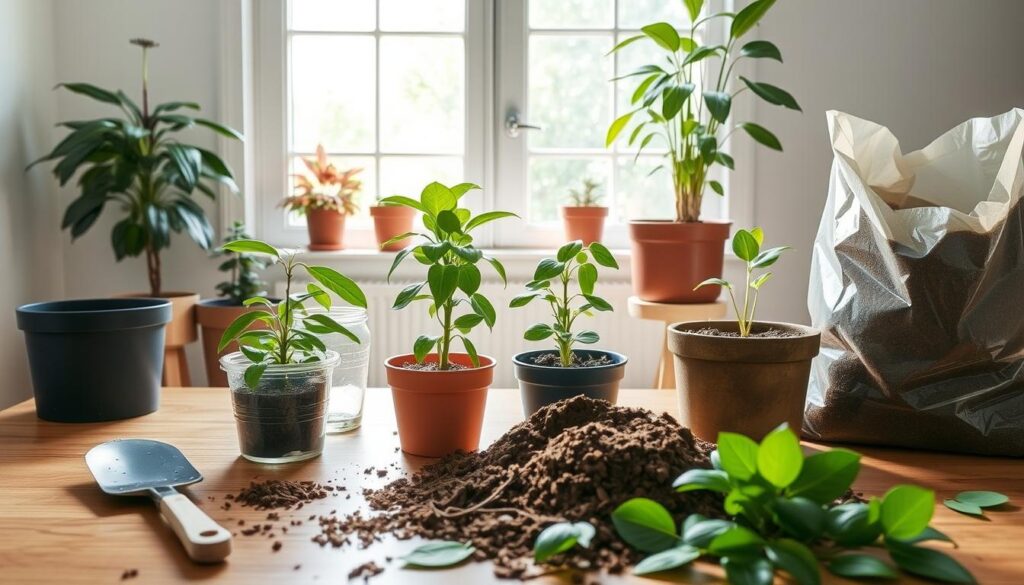Did you know nearly 90% of indoor plants become root-bound in their first year? This fact shows how crucial repotting is for their health. If you’re curious about repotting indoor plants right, you’re in good company. It’s a key step to help your plants grow strong and healthy.
In this guide, we’ll cover the best times and ways to repot houseplants. We’ll also talk about when your plants might need a new home. We’ll use insights from “The Plant Lover’s Guide to Houseplants” by Richie Steffen. Our goal is to give you the best tips for repotting indoor plants, so they can thrive.
Key Takeaways
- Repotting is crucial for the health of indoor plants.
- Most plants require repotting at least once a year to thrive.
- Indicators of a plant needing repotting include stunted growth and visible roots.
- The right timing and pot choice are critical for successful repotting.
- Using the proper potting mix enhances root health and growth.
- Aftercare following repotting is essential for maximizing growth.
Understanding the Need for Repotting
Knowing when to repot indoor plants is key to keeping them healthy. Repotting lets you refresh the soil and give the roots more room. It ensures your houseplants stay vibrant and strong.
Signs Your Indoor Plant Needs Repotting
Spotting the signs that your indoor plants need repotting is crucial. Look out for these common signs:
- Root overcrowding: Roots may start to emerge from drainage holes.
- Stunted growth: Plants fail to grow or produce new leaves.
- Yellowing leaves: A sign that the plant might be struggling with nutrient depletion.
Benefits of Repotting for Plant Health
Repotting offers more than just a new pot. It brings several benefits to your plants:
- Improved soil quality, which enhances nutrient retention.
- Better nutrient absorption, allowing for healthier growth.
- Increased space for root growth, leading to more robust plants.
Choosing the Right Pot for Repotting
Choosing the right pot is key for your indoor plants’ health and growth. When choosing a pot for repotting indoor plants, size and materials matter a lot. They affect drainage, root growth, and plant health.
Selecting the Appropriate Size
Getting the right pot size is important for your plants to grow well. A good rule is to pick a pot 1-2 inches bigger than the current one. This lets roots grow without stressing the plant. Even a half-inch bigger pot can help with moisture and air.
Materials to Consider for Pots
The best pots for houseplants vary in materials, each with pros and cons. Here are some common ones:
- Terracotta: Great for absorbing moisture; good for plants that like dry soil.
- Ceramic: Decorative and keeps moisture well, but can be heavy.
- Plastic: Light and durable; comes in many styles, with good drainage if designed right.
Think about your plant’s needs when picking potting materials. Each material has its own benefits for growth and health during repotting.
The Best Soil for Indoor Plants
Choosing the right soil is key for healthy indoor plants. It affects their growth and health. Knowing the best soil for repotting can improve your plant care. Different mixes meet different plant needs, helping each species thrive.
Types of Potting Mixes
There are many potting mixes, each for specific plants. For the best plant health, consider these:
- Cactus Mix: Great for succulents, it drains well and doesn’t hold water.
- Orchid Mix: For epiphytic plants, it has bark and charcoal for good airflow.
- Seed Starting Mix: Light and sterile, it’s perfect for starting seeds.
- All-Purpose Mix: A versatile mix for most houseplants, with peat, vermiculite, and perlite.
How to Create Your Own Potting Mix
Homemade potting soil is a great option for plant lovers. A simple recipe is:
- 1 part peat moss: Adds organic material and holds moisture.
- 1 part perlite or vermiculite: Improves drainage and aeration.
- 1 part compost: Provides nutrients and beneficial microbes.
Mixing these parts equally makes a great homemade potting soil. It ensures your indoor plants get the nutrients they need to grow.
Tools You’ll Need for Repotting
Repotting your indoor plants is easy with the right tools. Different gardening tools make the process smoother. They help your plants adjust to new pots well.
Essential Gardening Tools
Every plant lover needs these essential gardening tools for repotting:
- Pots: Pick the right size for your plants to grow.
- Trowels: Great for moving soil and breaking up roots.
- Pruning Shears: Good for cutting roots and leaves if needed.
- Fertilizer Spikes: Add nutrients to the soil after repotting.
Optional Tools for Ease of Use
Some optional gardening tools can make repotting easier:
- Watering Can with Spout: Water your plants precisely at the base.
- Gardening Gloves: Keep your hands clean and safe from cuts.
- Soil Moisture Meter: Check soil moisture levels for better care.

Preparing Your Plant for Repotting
Getting your indoor plants ready for repotting is key. It helps them adjust smoothly to their new home. You need to water them well before and check their roots for any problems.
Watering Before Repotting
Watering your plant before repotting is vital. It keeps the soil moist and makes it easier to move the plant. Water your plant 1-2 days before to help it adjust better.
A hydrated plant is less likely to get damaged during the move. This step reduces stress and shock for your plant.
Inspecting Roots and Foliage
Checking the roots is a must. Look for rot, overcrowding, or pests. Healthy roots are firm and white or light tan.
Also, check the leaves for pests or diseases. Fixing these issues before repotting helps your plant thrive in its new spot.
| Preparation Step | Description |
|---|---|
| Watering | Hydrate the plant 1-2 days before repotting to minimize stress. |
| Root Inspection | Examine roots for rot and overcrowding to ensure plant health. |
| Foliage Check | Look for pests or diseases on leaves to protect overall plant vitality. |
Step-by-Step Guide to Repotting
Repotting indoor plants needs careful steps and gentle handling. This guide helps you do it right, keeping your plants healthy and growing well.
Removing the Plant from Its Current Pot
First, water your plant a day before repotting. This makes the soil easier to handle. Gently tilt the pot and tap the sides to loosen the soil. Then, grasp the plant base and carefully lift it out.
Be careful not to pull on the stem. This can hurt the plant.
Placing the Plant in the New Pot
Now, put the plant in its new home. Pick a pot that’s just a bit bigger than the old one. This helps the roots grow well.
Put a layer of soil at the bottom and place the plant in the center. Make sure the soil level is the same as before. This is key for a successful transplant.
Filling with Soil and Watering
Fill the sides of the root ball with new soil. Press it gently to remove air pockets but don’t pack it too hard. Once the pot is full, water the plant well.
This helps the soil settle and gives the plant the moisture it needs. After repotting, keep watering regularly to help the plant recover and grow.

This detailed guide covers all the steps for repotting indoor plants. It ensures a successful transplant and keeps your plants healthy.
Aftercare for Newly Repotted Plants
Proper care after repotting is key for your plants’ health. The move to a new pot can be tough. The right light and water are crucial.
Optimal Light Conditions
Put your plants in bright, indirect light right after repotting. This helps them adjust without shock. Don’t put them in direct sunlight yet. It’s too harsh for stressed plants.
Slowly move them to their usual light spot. This helps them grow well.
Watering Routine Post-Repotting
Watering new plants needs care. Let the soil dry a bit before watering again. Too much water can cause root rot.
Check the soil moisture by feeling the top inch. If it’s dry, it’s time to water. Keeping a regular watering schedule helps maintain the right moisture.
Common Mistakes to Avoid When Repotting
Repotting can greatly improve your indoor plants’ health and growth. Yet, many gardeners make common mistakes. Knowing these errors can help you get better results and keep your plants healthy.
Overwatering After Repotting
One big mistake is overwatering right after repotting. This can make the soil too wet, leading to root rot and fungal problems. To prevent this, let the soil dry a bit before watering again. Check the soil moisture and only water when it’s dry about an inch down.
Choosing an Oversized Pot
Another issue is picking a pot that’s too big for your plant. It might seem like a good idea, but it can actually harm your plant. A better choice is a pot that’s only one size bigger than the current one. This helps your plant’s roots grow well and promotes healthy growth.
Timing Your Repotting Correctly
Choosing the right time to repot indoor plants is key for their growth and health. Spring and early summer are the best times. Plants grow well during these seasons, making it easier for them to adjust to a new pot.
Spring is a great time because plants are full of energy. It’s the perfect moment to repot them.
Best Seasons for Repotting
Spring and early summer are warm and good for root growth. Repotting in fall or winter can stress plants. They might be trying to survive instead of growing.
Knowing your plants’ natural cycles helps you choose the best time to repot.
Factors Affecting Repotting Timing
Season is important, but other factors matter too. The type of plant and its age and health are key. Some plants need to be repotted at specific times.
If your plant looks stressed, like it’s not growing or has yellow leaves, it might need a new pot. Considering these factors ensures a smooth transition.
FAQ
When should I repot my indoor plants?
Spring or early summer is the best time to repot indoor plants. Look for signs like root overcrowding, stunted growth, or yellowing leaves. These signs mean your plant needs a bigger home.
How do I know when my houseplants need repotting?
Check if roots are growing out of the drainage holes. If the soil dries out fast or your plants wilt, it’s time to repot.
What type of soil is best for repotting indoor plants?
The right soil depends on the plant type. Use a high-quality potting mix with organic matter. Some plants need special mixes, like cactus soil or orchid mix.
Can I use garden soil for repotting indoor plants?
No, garden soil is not good for indoor plants. It’s too dense and might have pests or diseases. Use a lightweight potting mix made for houseplants instead.
What tools do I need for repotting my plants?
You’ll need pots, trowels, and pruning shears. Gloves and watering cans with spouts can also help.
How should I prepare my indoor plants before repotting?
Water your plants 1-2 days before to reduce stress. Check for overcrowded roots and pests or disease on the foliage.
What is the best method for removing a plant from its pot?
Gently squeeze the pot’s sides to loosen the soil. Then, carefully tilt and slide the plant out without damaging the roots.
How do I care for my plants after repotting?
Place your plants in indirect light for a few weeks. Keep a careful eye on watering to avoid overwatering as the roots adjust.
What are common mistakes to avoid when repotting?
Avoid overwatering right after repotting. Also, don’t choose pots that are too large, as this can cause poor growth and uneven watering.
How often should I repot my houseplants?
Repot every 1-2 years, but it depends on the plant. Watch for signs that your plant needs more space.


